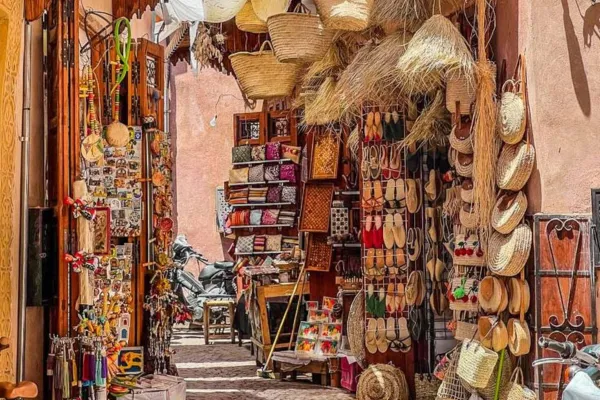Marrakech Travel Guide: How to Spend 3 Days in Marrakech
Discover the ultimate Marrakech travel guide that will transform your Moroccan adventure from ordinary to extraordinary. As a seasoned travel expert, I’m excited to unveil the most comprehensive insights into Marrakech, a city that promises an unforgettable journey through culture, history, and breathtaking experiences.
Table of Contents


Why Marrakech Travel Guide Matters
Marrakech isn’t just a destination; it’s a vibrant tapestry of experiences waiting to be explored. This Marrakech travel guide will walk you through the most mesmerizing attractions, hidden gems, and practical tips to make your trip truly remarkable.
1. Jardin Marjorelle: A Colorful Oasis in Your Marrakech Travel Guide
Begin your Marrakech travel adventure at the legendary Jardin Marjorelle. This botanical garden, immortalized by fashion designer Yves Saint Laurent, offers a stunning escape from the city’s bustling streets. The electric blue buildings and exotic plant collections create a photographer’s paradise.
2. Medersa Ben Youssef: Historical Treasure in Our Marrakech Travel Guide
No Marrakech travel guide would be complete without exploring the Medersa Ben Youssef. This 14th-century Islamic college showcases breathtaking architectural details that will transport you through centuries of Moroccan craftsmanship.
3. Exploring the Medina: Heart of Your Marrakech Travel Experience
The Medina represents the soul of Marrakech. Our travel guide recommends losing yourself in its narrow streets, where every corner reveals a new mystery. Traditional craftsmen, hidden courtyards, and centuries-old architecture await your discovery.
4. Jemaa el-Fna Square: The Pulse of Marrakech
A quintessential stop in any Marrakech travel guide, Jemaa el-Fna Square transforms from a marketplace by day to an electrifying performance venue by night. Street performers, food stalls, and local entertainment create an immersive cultural experience.
5. La Mamounia: Luxury in Your Marrakech Travel Journey
For a touch of elegance, our Marrakech travel guide recommends visiting La Mamounia. This iconic hotel offers stunning gardens, exquisite architecture, and a glimpse into Moroccan luxury.
6. Place des Epices: A Sensory Delight
Your Marrakech travel experience isn’t complete without exploring the Spice Square. Vibrant colors, enticing aromas, and traditional spice merchants create an unforgettable sensory journey.
7. Relaxation: Hammam and Pools
Every Marrakech travel guide suggests taking time to relax. Experience a traditional hammam or enjoy the luxurious pools that dot the city’s landscape.
Where to Stay During Your Marrakech Travel
[Previous accommodation section remains the same]
Day Trips from Marrakech
[Previous day trips section remains the same]
Essential Marrakech Travel Tips
- Dress respectfully and understand local cultural norms
- Learn basic Arabic or French phrases
- Carry cash and be prepared to negotiate prices
- Stay hydrated and protect yourself from the sun
- Embrace unexpected experiences
External Resources for Your Marrakech Travel
For more information, check out:
- Official Moroccan Tourism Website – Comprehensive travel resources
- Lonely Planet Marrakech Guide – Detailed travel insights
- UNESCO World Heritage Site Information – Cultural context for Marrakech
Marrakech is more than a destination – it’s a life-changing experience that will leave an indelible mark on your travel memories. This Marrakech travel guide is your passport to an extraordinary adventure.
Frequently Asked Questions About Marrakech Travel
Q1: What is the best time to visit Marrakech?
The ideal time to visit Marrakech is during spring (March to May) or autumn (September to November) when temperatures are mild and comfortable. These seasons offer pleasant weather for exploring the city, with daytime temperatures ranging from 70-80°F (21-27°C).
Q2: Is Marrakech safe for tourists?
Marrakech is generally safe for tourists, but like any popular destination, it’s important to take standard precautions. Be aware of your surroundings, protect your belongings, and avoid walking alone in isolated areas at night. Most locals are friendly and welcoming to tourists.
Q3: Do I need a visa to visit Marrakech?
Many nationalities, including those from the US, UK, and EU countries, can enter Morocco without a visa for up to 90 days. However, always check the latest entry requirements with your local Moroccan embassy before traveling.
Q4: What currency is used in Marrakech?
The Moroccan Dirham (MAD) is the local currency. While some high-end hotels and restaurants accept credit cards, it’s recommended to carry cash for markets, small shops, and local experiences.
Q5: How should I dress in Marrakech?
Respect local cultural norms by dressing modestly. For women, this means covering shoulders and knees. Men should avoid very short shorts. Light, breathable fabrics are best due to the warm climate.
Q6: Is English widely spoken in Marrakech?
While Arabic and French are the primary languages, many people in the tourism industry speak some English. Learning a few basic Arabic or French phrases will be appreciated by locals and enhance your travel experience.
Q7: What are the must-try local foods in Marrakech?
Don’t miss these local delicacies:
- Tagine (slow-cooked stew)
- Couscous
- Pastilla (sweet and savory pastry)
- Mint tea
- Moroccan bread
- Harira (traditional soup)
Q8: How do I get around Marrakech?
Transportation options include:
- Walking (best for exploring the Medina)
- Petit taxis (small, metered taxis)
- Grand taxis (for longer distances)
- Guided tours
- Occasional horse-drawn carriages
Q9: What should I know about haggling in Marrakech?
Bargaining is an expected part of shopping in markets. Start by offering about 40% of the initial asking price and be prepared to negotiate. Always remain friendly and respectful during the process.
Q10: Are there any cultural customs I should be aware of?
- Ask permission before photographing people
- Respect religious sites and dress codes
- Remove shoes when entering mosques or private homes
- Use your right hand for eating and passing items
- Ramadan may affect business hours and local customs

